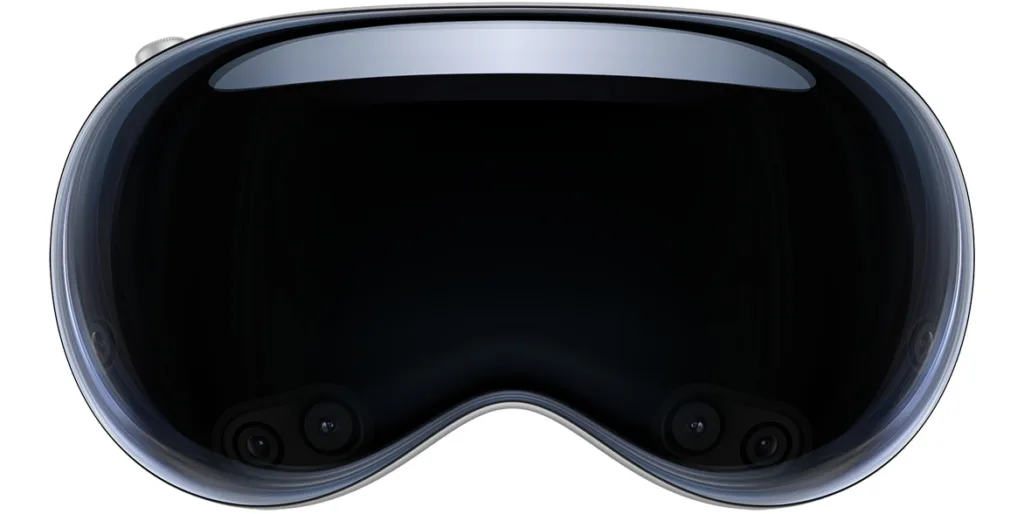Apple Vision Pro is Apple’s bold entry into the world of mixed reality. Announced as a groundbreaking headset, it blends digital content with your physical environment. Unlike traditional VR headsets, it lets you stay connected to your surroundings while enjoying immersive experiences. Apple calls it a “spatial computer,” and for good reason.
You can control it with your eyes, hands, and voice—no controllers required. From watching movies in 3D to working on multiple virtual screens, this device brings the future to your face.
Apple Vision Pro Features: What Makes It So Unique?
Let’s break down what makes this gadget so powerful.
- Micro-OLED Display: Over 23 million pixels across two lenses. That’s more than one 4K TV in each eye.
- Eye Tracking: It follows your gaze, making navigation super intuitive.
- Gesture Control: Tap your fingers in the air to select, scroll, and zoom.
- VisionOS: Apple’s brand-new operating system built specifically for spatial computing.
- Apps in 3D Space: Open apps around you. Resize them. Move them. You’re not limited to a screen anymore.
- Immersive Audio: Spatial audio makes it feel like sound is coming from your surroundings.
All of this adds up to an experience that feels natural, powerful, and futuristic.
Apple Vision Pro and Mixed Reality: How It Redefines Digital Experiences
Apple Vision Pro doesn’t just show you a virtual world. It blends the digital and physical together. This is called mixed reality, and Apple is pushing it to new heights.
Imagine sitting in your living room and opening Safari, Mail, and Photos—all floating around you. Or watching a movie on a screen that looks 100 feet wide, yet exists only in your headset. During the Apple Vision Pro demo, Apple showcased this exact experience, and it blew people away.
This isn’t just VR. It’s a new way to interact with digital life, without disconnecting from the real world.
The Design and Build of Apple Vision Pro: Sleek, Smart, and Comfortable
Apple is known for beautiful design, and Vision Pro is no exception.
The headset looks sleek and modern, with a front-facing glass panel that shows a digital version of your eyes. Yes, others can see your reactions. It feels more human than other headsets.

It is constructed of aluminum and soft cloth for comfort. The headband is adjustable. There’s also a modular design that fits different face shapes and even works with prescription lenses.
Despite being packed with tech, it feels light and breathable. A battery pack clips to your waist for better weight distribution.
Apple Vision Pro Use Cases: From Work to Entertainment
This headset isn’t just for fun. It’s built for productivity too.
- Work: Open multiple apps, spread them across your space, and stay focused. Use FaceTime in 3D, and even mirror your Mac.
- Entertainment: Watch Apple TV+ or Disney+ in cinematic environments. Games feel more immersive than ever.
- Creativity: Edit videos, build 3D models, or explore photos like never before.
In the Apple Vision Pro demo, users explored an app-filled workspace, watched a movie on a virtual screen, and navigated their digital life in 3D. It is a device for every aspect of your day.
Apple Vision Pro vs. Competitors: How It Stacks Up
The biggest question people ask: Apple Vision Pro vs Meta Quest 3—which is better?
Let’s compare:
| Feature | Apple Vision Pro | Meta Quest 3 |
|---|---|---|
| Display | Dual 4K Micro-OLED | LCD |
| Controls | Eye + Hand + Voice | Controllers + Hand tracking |
| Price | Much higher | Budget-friendly |
| OS | visionOS | Meta OS |
| Apps | Apple ecosystem | Meta Store |
| Build | Premium materials | Lightweight plastic |
While Meta Quest 3 offers great value, Vision Pro delivers unmatched quality and seamless Apple integration. If you’re already in the Apple ecosystem, Vision Pro feels like a natural upgrade.
Is Apple Vision Pro Worth the Price? A Value Breakdown
The Apple Vision Pro price starts at $3,499. That’s a huge investment. But is it worth it?
It depends on what you’re looking for. If you want the most advanced headset on the market, with next-level performance and integration, it could be worth every penny. It replaces a TV, a monitor, and even a computer in some cases.
But for casual users, or gamers on a budget, cheaper alternatives like the Meta Quest 3 may offer better value.
Still, early Apple Vision Pro sales show strong demand, especially from tech enthusiasts and developers.
How Developers Are Embracing Apple Vision Pro
Developers are already jumping in. Apple introduced visionOS SDK, which allows them to build apps specifically for this device.
Popular apps like Zoom, Microsoft Office, and Adobe Lightroom are being reimagined for spatial use. We’re also seeing brand-new experiences being built from scratch.
Apple is creating a whole new app ecosystem, and developers are excited to explore what’s possible in 3D space.
Apple Vision Pro in 2025: What the Future Holds
The future is already unfolding. Rumors are swirling about Apple Vision Pro 2, which may be lighter, faster, and more affordable. Apple often refines its first-gen products quickly, so it’s likely we’ll see a new version soon.
Meanwhile, more updates are coming to visionOS, with better multitasking and more third-party support. As more people adopt it, expect more apps, games, and use cases.
Apple Vision Pro may just be the first step in a larger plan to replace our screens entirely.
Is Mixed Reality’s Future in Apple Vision Pro?
Absolutely. Apple Vision Pro isn’t just another headset—it’s a whole new way to interact with technology. With its sleek design, powerful features, and groundbreaking user interface, it’s redefining what we expect from digital devices.
It may not be for everyone—especially at this price—but it shows us where the future is heading.
And that future looks incredibly exciting.

